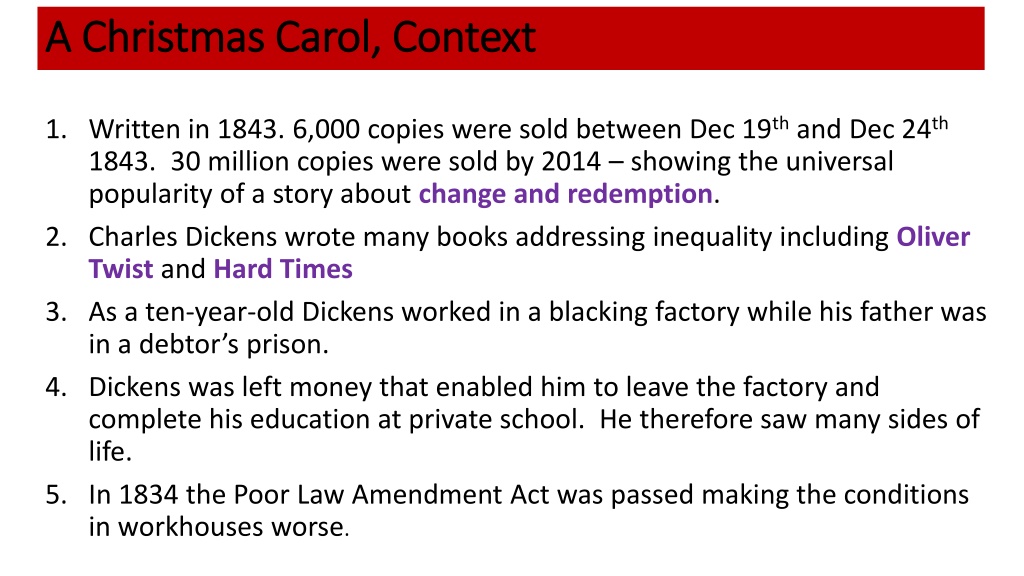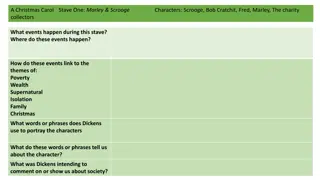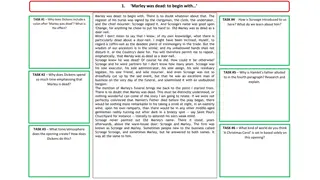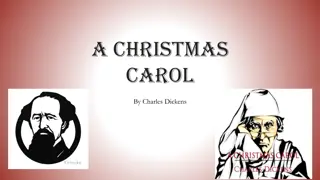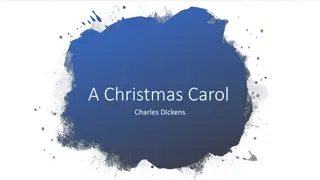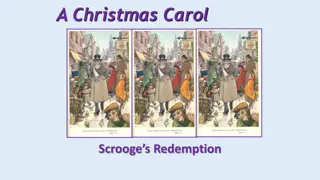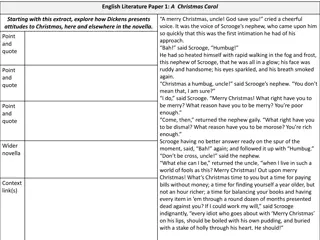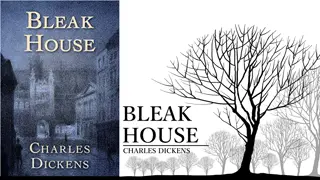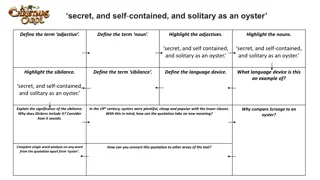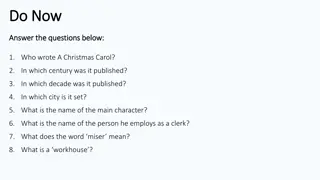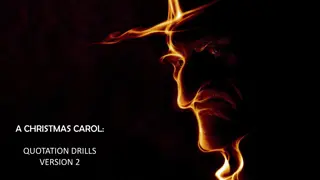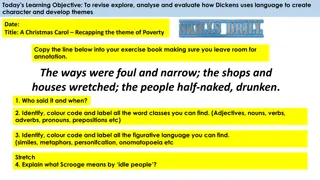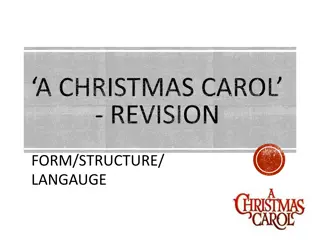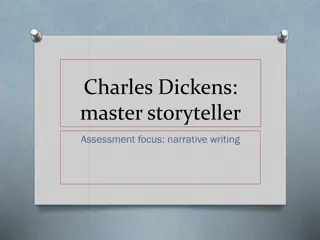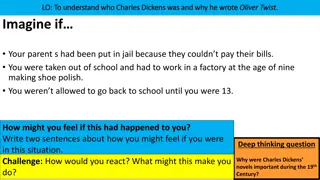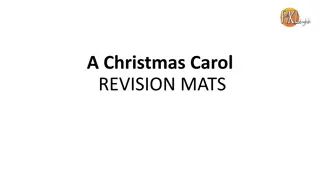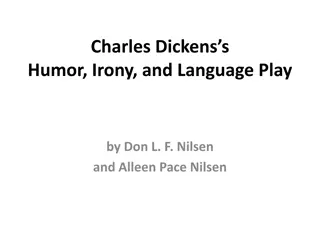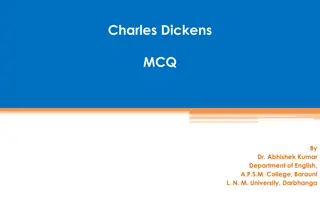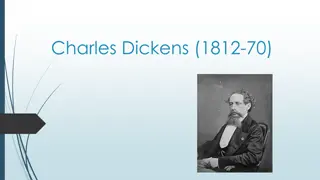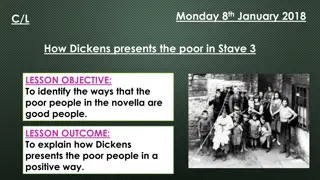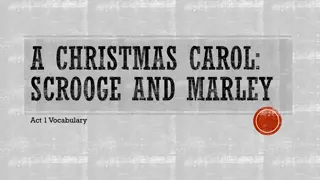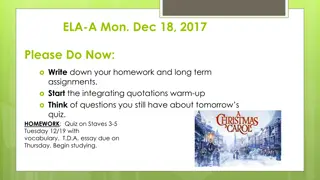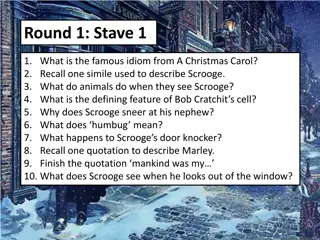Exploring the Context and Staves of A Christmas Carol by Charles Dickens
In this comprehensive content, the historical context of Charles Dickens' A Christmas Carol is discussed, highlighting its themes of social inequality and redemption. It delves into Dickens' personal experiences and beliefs, connecting them to the narrative of the novella. The summaries of Staves 1, 2, and 3 are also provided, giving insights into Scrooge's transformation through encounters with ghosts from past, present, and future. The images included visually enhance the understanding of key aspects of the story.
Download Presentation

Please find below an Image/Link to download the presentation.
The content on the website is provided AS IS for your information and personal use only. It may not be sold, licensed, or shared on other websites without obtaining consent from the author. Download presentation by click this link. If you encounter any issues during the download, it is possible that the publisher has removed the file from their server.
E N D
Presentation Transcript
A Christmas Carol, Context A Christmas Carol, Context 1. Written in 1843. 6,000 copies were sold between Dec 19thand Dec 24th 1843. 30 million copies were sold by 2014 showing the universal popularity of a story about change and redemption. 2. Charles Dickens wrote many books addressing inequality including Oliver Twist and Hard Times 3. As a ten-year-old Dickens worked in a blacking factory while his father was in a debtor s prison. 4. Dickens was left money that enabled him to leave the factory and complete his education at private school. He therefore saw many sides of life. 5. In 1834 the Poor Law Amendment Act was passed making the conditions in workhouses worse.
A Christmas Carol, Context A Christmas Carol, Context 6. INTERTEXTUALITY from the work of economist Thomas Malthus who believed that there were too many people and not enough food therefore the poor should die. Dickens believed there was plenty of food (as presented in Stave 3) but that it should be shared more equally. Decrease the surplus population this phrase spoken by Scrooge is 7. 8. rich and the poor. This is a key theme of the novella. 9. Charles Dickens was a social campaigner who did a lot for the poor. He was even asked to stand for parliament twice as a Liberal MP. Dickens had a sister called Fanny who died of tuberculosis. Victorian Prime Minister Benjamin Disraeli said that Britain was two nations: the 10. terrible poverty which was partly a result of the Industrial Revolution where thousands of people moved to London seeking work but ended up living in slums. In 1860 half the graves in London were of children under ten. This shows the
A Christmas Carol, Stave 1 summary A Christmas Carol, Stave 1 summary 1. The reader is introduced to Scrooge who only cares about making money. It is Christmas Eve and he won t pay to heat the office properly. This means that his clerk Bob Cratchitt, is very cold. 2. Scrooge has FOUR Christmas visitors: his nephew, Fred; two charity collectors; and a carol singer. Scrooge is rude to all of them and sends them ALL away. 3. That night the Ghost of Jacob Marley, his dead business partner, appears. He tells Scrooge that his mean way of life will lea ot misery and that three ghosts will visit him to show him the error of his ways.
A Christmas Carol, Stave 2 summary A Christmas Carol, Stave 2 summary 1. The ghost of Christmas Past shows Scrooge his unhappy childhood. 2. They visit the house of Scrooge s first employer Fezziwig, who is holding a Christmas party. Scrooge notices how much happiness can be obtained from very little money. 3. Scrooge sees himself as a younger man with Belle, the woman he was engaged to marry. Belle breaks off the engagement because she thinks Scrooge loves money more than her.
A Christmas Carol, Stave 3 summary A Christmas Carol, Stave 3 summary 1. The Ghost of Christmas Present takes Scrooge to visit Christmas preparations at the Cratchit s house. Scrooge learns that Tiny Tim will not survive unless the future changes. This knowledge upsets Scrooge. 2. The Ghost takes Scrooge to see different groups of people enjoying themselves at Christmas. Scrooge sees his nephew, Fred, with his family. They are discussing Scrooge and Fred is full of pity for him. 3. At the end of the night the Ghost shows Scrooge two children: a boy, called Ignorance, and a girl, called Want. The Ghost says they belong to Man and warns Scrooge to beware of them both, but especially to beware of Ignorance.
A Christmas Carol, Stave 4 summary A Christmas Carol, Stave 4 summary 1. The mysterious Ghost of Christmas Yet To Come takes Scrooge into the future to witness different conversations about a dead man. No one cares that this man has died, and the thieves have so little respect that they have stolen the clothes from his corpse. 2. In contrast, the Ghost then takes Scrooge to see the Cratchits who are deeply upset because Tiny Tim has died. 3. Finally Scrooge is shown a gravestone with his own name on it. He realises he is the dead man whom the people were talking about. He promises to change his ways.
A Christmas Carol, Stave 5 summary A Christmas Carol, Stave 5 summary 1. Waking up in his own bed, back in the present, Scrooge is delighted to be given a second chance and makes Christmas happy for everyone. 2. He sends a turkey to the Cratchits. 3. He gives money to the charity collectors. 4. He joins Fred for Christmas. 5. The next day he raises Bob s wages and promises to become a second father to Tiny Tim, who does not die.
Quotations you (probably) already know: A Christmas Carol Quotations you (probably) already know: A Christmas Carol Stave 1 Stave 2 Stave 4 Dead as a door nail Another idol has displaced me Show me someone who shows emotion at death Bah! Humbug! One enormous smile Solitary as an oyster My little, little child Stave 3 Are there no prisons Four-roomed house Stave 5 God bless us everyone Decrease the surplus population Brave in ribbons
A Christmas Carol: recommended quotations to learn These quotations are particularly useful as they show meaning as well as character or theme AND terminology Quotation Theme/character (AO1) Terminology (AO2) 1 [fog] pouring in every chink and keyhole The weather is like an additional character in the novella PATHETIC FALLACY is used to give attitude to the menacing fog which is mentioned several times in stave 1. The change in the weather MIRRORS the change in Scrooge 2 Decrease the surplus population Scrooge thinks the poor should die rather than him donate to charity CONTEXT this is a key quotation for MALTHUSIAN economics (see context) 3 Gloomy suite of rooms Scrooge lives in a large house but it is depressing he is well off but not happy PATHETIC FALLACY is used to give attitude to Scrooge s accommodation. 4 Doomed, fettered, ponderous These adjectives describe the chain on Jacob Marley NEGATIVE ADJECTIVES add to the weight of the chain/the burden that Marley has to carry 5 Guilty governments Scrooge sees the lamenting ghosts unable to help victims of government CONTEXT (dislike of treatment of the poor in society) is emphasised by the ALLITERATION 6 Scrooge said he knew it. And he sobbed Spirit shows Scrooge his lonely childhood in school MONOSYLLABIC SIMPLE sentence gives weight to the sensitivity and sadness of Scrooge which juxtaposes with his character in stave 1.
A Christmas Carol: recommended quotations to learn These quotations are particularly useful as they show meaning as well as character or theme AND terminology Quotation Theme/character (AO1) Terminology (AO2) 7 Comfortable, oily, rich, fat, jovial . Laughed, wonderful Fezziwig s voice gives a sense of positive indulgence emphasising that he indulges his employees at Christmas ASYNDETIC LISTING of adjectives followed by further positive vocabulary 8 A small matter to make these silly folk so full of gratitude The ghost of Christmas past criticises Fezziwig and the employees in order to provoke a reaction from Scrooge PROVOKATIVE STATEMENT including the BELITTLING (silly folk) judgement on the employees 9 Another idol has replaced me Belle says that she has been replaced by money PERSONIFICATION of money. Belle has been replaced by the lure of wealth, due to Scrooge s AVARICE (greed)
A Christmas Carol: recommended quotations to learn These quotations are particularly useful as they show meaning as well as character or theme AND terminology Quotation Theme/character (AO1) Terminology (AO2) 10 Decide what men shall live, what men shall die Ghost of Christmas Present makes a political comment about the government s cruel policies that contribute to a divided society SYNTACTICAL PARALLELISM emphasises the different words in the two lines: live, die 11 It slowly, gravely, silently approached The final ghost s entrance is shown with ominous language that slows the pace The multiple ADVERBS give an ominous feel and the adverb gravely could FORESHADOW the final important siting by Scrooge of his own grave. 12 The whole quarter reeked with crime, with filth, and misery The fourth spirit (resembling the grim reaper) takes Scrooge to Old Joe s pawnbroker style shop. Dickens used to walk many miles across London at night observing life and the impact of the Industrial Revolution and the divided society. SEMANTIC FIELD of the impact of poverty shown in crime, filth and misery. (a semantic field is a group of words about the same topic)
A Christmas Carol: recommended quotations to learn These quotations are particularly useful as they show meaning as well as character or theme AND terminology Quotation Theme/character (AO1) Terminology (AO2) 13 Unwatched, unwept, uncared for Scrooge s dead body on his bed when the curtains are removed and his shirt is swapped The repetition of the negative prefix Un emphasises loneliness and neglect 14 As merry as a schoolboy This is one of 4 similes to describe Scrooge s happiness of Christmas day. It is IRONIC that Dickens has used this simile as the depiction of school and boys in the novella is mostly negative. On the other hand it shows Scrooge reverting to the happy image of himself using his imagination to conjur up images of Ali Baba, the princess and the parrot 15 Clash, clash, hammer, ding, dong, bell In stave 5 Scrooge is born again (Christian imagery) and the bells celebrate. The MULTIPLE ONOMATOPOEIAS give a complete feel of celebration, juxtaposing with the earlier use fo multiple onomatopoeias when the bell rang announcing Marley s arrival in stave 1. This is an example of the CYCLICAL STRUCTURE of the book (including coal in the fireplace)
